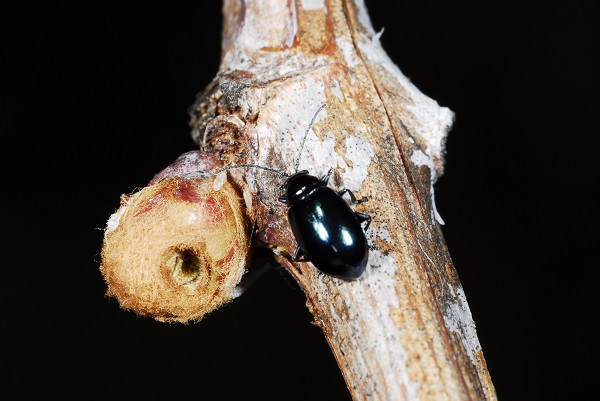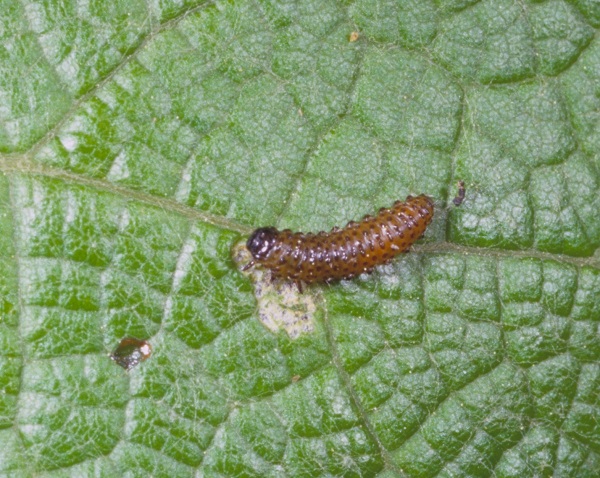Grape Flea Beetle
ENTFACT-224: Grape Flea Beetle | Download PDF
by Ric Bessin, Extension Specialist
University of Kentucky College of Agriculture
Grape flea beetle is found in the eastern two-thirds of the United States. Adults eat buds and unfolding leaves, resulting in hollowed out and leaves that emerge ragged and tattered. This may reduce the numbers of primary and secondary fruit clusters.

Figure 1. Grape flea beetle and damage.
Larvae feed on flower clusters and skeletonize leaves in a manner similar to adult rootworm feeding. Hosts include primarily wild and cultivated grapes and Virginia creeper.
Adults are dark metallic greenish-blue, jumping beetles about 1/5 inch long; larvae are brownish and marked with black spots; eggs are pale yellow, and fairly conspicuous on upper leaf surface or under loose cane bark.
Adults overwinter in protected areas around vineyards, and start feeding on interior of primary buds and opening grape leaves in early spring. These are often the first insect pests to begin attacking grapes. Damaged buds will not develop into primary canes which can reduce yields. It is this injury to the developing buds that can cause economic losses in some years. Once the buds are 1/2 inch long, only slight injury is caused.

Figure 2. Grape flea beetle larva.
The females lay eggs under loose cane bark on vines, or occasionally on leaf upper surfaces, or on buds. The light yellow fairly conspicuous eggs hatch in a few days. The larvae feed on leaves for 3 to 4 weeks, then drop to the ground where they pupate in the soil, and emerge as adults in 1 to 2 weeks later. While the larvae do injure the leaves, they are rarely of economic importance. New adults feed for the remainder of the summer and go into hibernation in the fall. There is only 1 generation per year.
Management
Damage is often restricted to vineyard borders, particularly near wooded areas. When grape flea beetle is a problem, it occurs early in the season, just when the buds begin to swell. Scheduled sprays for grape berry moth and other insect pests occur later in the season are of little benefit as they do not coincide with early flea beetle activity. When flea beetles are common and injury to the small buds is observed, a spray timed at bud swell will provide control.
Revised: 11/19
CAUTION! Pesticide recommendations in this publication are registered for use in Kentucky, USA ONLY! The use of some products may not be legal in your state or country. Please check with your local county agent or regulatory official before using any pesticide mentioned in this publication.
Of course, ALWAYS READ AND FOLLOW LABEL DIRECTIONS FOR SAFE USE OF ANY PESTICIDE!
Photos courtesy Ric Bessin, University of Kentucky Entomology
